- Joined
- Feb 2, 2011
- Messages
- 2,348
NEW RELEASES FOR JANUARY 2025
THE EIGHTEENTH CENTURY COLLECTION
THE AMERICAN WAR OF INDEPENDENCE
THE BATTLE OF BUNKER HILL, 17th JUNE 1775.
THE ASSAULT ON THE REDOUBT AT BREED’S HILL
Boston was the third largest town in North America, and stood on a Peninsula connected to the mainland by a neck just wide enough to cross at high tide. The harbour, large enough to be strategically significant, and central to the town’s economy, was formed by a chain of islands stretching out to sea, guarded by reefs and ledges.
North west of Boston was Charlestown, a largely rural peninsula one and a half miles long. Charlestown stood at the south east corner with three hills behind it. Bunker’s Hill, nearest the neck of the Peninsula, Breed’s Hill 200 yards above the town and Moulton’s Hill to the north east.

On the 16th June 1775, 3 detachments from Massachusetts regiments under the command of Colonel William Prescott and engineer Captain Richard Gridley, crossed the Charlestown neck and arrived at Bunker Hill.
Captain Richard Gridley and Prescott disagreed as to where they should locate their defense. Some work was performed on Bunker Hill, but Breed’s Hill was closer to Boston and viewed as being more defensible, and they decided to build their primary redoubt there.
Prescott and his men began digging a square fortification about 130 ft a side with ditches and earthen walls. The walls of the redoubt were about 6 feet high.
Work began at midnight, and around 4am one of the British warships spotted the earthworks on Breed’s Hill and opened fire.
The British command agreed that the works posed a significant threat, but were at this time sufficiently incomplete and isolated to offer a chance of a successful attack.
The original British plan was to bypass the redoubt to the north and capture Bunker’s Hill and the neck of the peninsula, thus isolating the redoubt on Breed’s Hill.
The Americans repulsed two British assaults, with significant British casualties. The British captured the redoubt on their third assault, after the defenders had run out of ammunition. The colonists retreated over Bunker Hill, leaving the British finally in control of the Peninsula.
The battle was a tactical victory for the British, but it proved to be a sobering experience for them; they incurred many more casualties than the Americans had sustained, including many officers. The battle had demonstrated that inexperienced militia were able to stand up to regular army troops in battle. Subsequently, the battle discouraged the British from any further frontal attacks against well defended front lines. American casualties were much fewer, although their losses included General Joseph Warren, and Major Andrew McClary, the final casualty of the battle.
THE AMERICAN ARMY
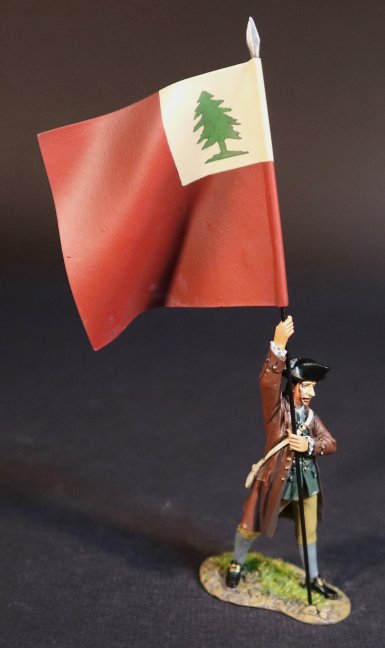
ABHL-02
THE AMERICAN WAR OF INDEPENDENCE 1775-1783,
THE BATTLE OF BUNKER HILL, JUNE 17th 1775,
THE ASSAULT ON THE REDOUBT AT BREED’S HILL,
THE AMERICAN ARMY,
STANDARD BEARER
BRITISH MARINES

The Marines, which only became “Royal Marines” in 1802, were the Royal Navy’s private army, administered by the Admiralty and controlled by senior naval officers. The rank and file were volunteers and wore army style uniforms and equipment. However they were trained to serve on warships and undertake amphibious operations. The 50 companies, shared between Chatham, Portsmouth and Plymouth, were not regimented, and detachments, or in some cases individual replacements were assigned on an ad hoc basis.
The first Marines sent to Boston were to form a battalion of 600 men under Major Pitcairn, but by March only 336 were present, as they soon became an object of inter service rivalry over pay, food and conditions. Although initially physically inferior to their army comrades, and short of essential equipment for service on land, incessant drilling and regular marches into the countryside soon created a fine unit.
Another group of over 700 men arrived in May, and the whole force formed two battalions, with grenadier and light companies.
The 1st and 2nd Marines were to play an important part in the assault on the southern defences of the Breed’s Hill redoubt.

MBHL-09
THE AMERICAN WAR OF INDEPENDENCE 1775-1783,
THE BATTLE OF BUNKER HILL, JUNE 17th 1775,
THE ASSAULT ON THE REDOUBT AT BREED’S HILL,
BRITISH MARINES,
2 BRITISH MARINES
It was during one of the assaults by the 47th Regiment and the 1st Marines, that the American commander Prescott ordered his men to hold their fire until the British were within 30 yards. This action supposedly gave rise to the order, “Don’t fire till you see the whites of their eyes”!
The volley forced the Marines and regulars back out of range to regroup.
Adjutant, Lieutenant Waller, managed to reform two companies, and with the 47th Regiment on their left, the two battalions finally swarmed over the defences and into the redoubt, probably being the first troops to enter.

MBHL-09N
THE AMERICAN WAR OF INDEPENDENCE 1775-1783,
THE BATTLE OF BUNKER HILL, JUNE 17th 1775,
THE ASSAULT ON THE REDOUBT AT BREED’S HILL,
BRITISH MARINES,
4 BRITISH MARINES
This third attack was made at the point of the bayonet and successfully carried the redoubt. However the final volleys of fire from the colonists cost the life of Major Pitcairn. The defenders had run out of ammunition, redusing the battle to close combat. The advantage turned to the British as their troops were equipped with bayonets on their muskets, while most of the colonists were not.
Colonel Prescott, one of the last men to leave the redoubt, parried bayonet thrusts with his normally ceremonial saber.
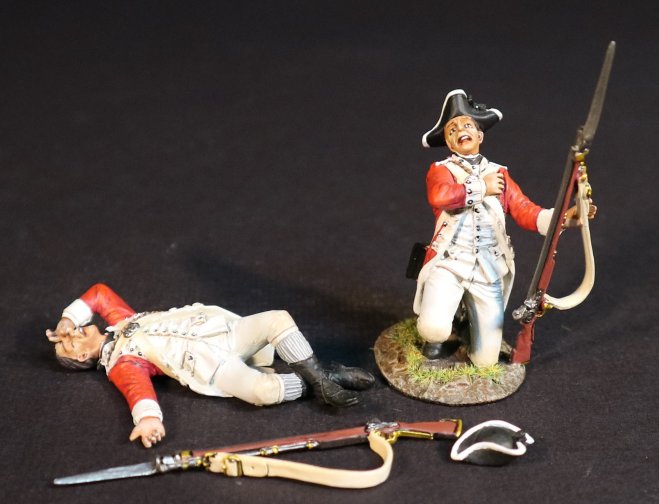
MBHL-14
THE AMERICAN WAR OF INDEPENDENCE 1775-1783,
THE BATTLE OF BUNKER HILL, JUNE 17th 1775,
THE ASSAULT ON THE REDOUBT AT BREED’S HILL,
BRITISH MARINES,
2 BRITISH MARINE CASUALTIES
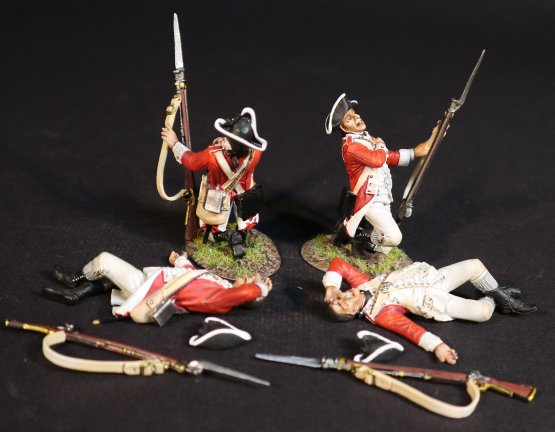
MBHL-14N
THE AMERICAN WAR OF INDEPENDENCE 1775-1783,
THE BATTLE OF BUNKER HILL, JUNE 17th 1775,
THE ASSAULT ON THE REDOUBT AT BREED’S HILL,
BRITISH MARINES,
4 BRITISH MARINE CASUALTIES
THE SEVEN YEARS WAR
THE THIRD CARNATIC WAR 1756-1763
THE BATTLE OF WANDEWASH, 22nd JANUARY 1760
THE BRITISH ARMY
The Battle of Wandewash was a confrontation between the French under the command of The Comte de Lally, and the British Sir Eyre Coote. It was the decisive battle in the Anglo French struggle in southern India during the Seven Years War.
Lally, cut off from sea support by the withdrawal of Admiral d’Aché’s fleet and hampered by a lack of funds and by dissensions among his troops, tried to recover the fort of Wandiwash near Pondicherry.
There he was attacked and routed by Coote, with about 1,700 British troops against about 2,000 French. Lally’s best general, the marquis de Bussy, was captured. The French were thereafter confined to Pondicherry, which surrendered on Jan. 16, 1761, after much privation. Lally was later imprisoned and executed, after a trial in Paris, for alleged treason
The following two British regular units served in India and were present at the battle of Wandewash. It should be noted however that it was rare for these units to serve as complete battalions, and that they were generally broken up into detachments.
THE 84th (COOTE’S) REGIMENT OF FOOT
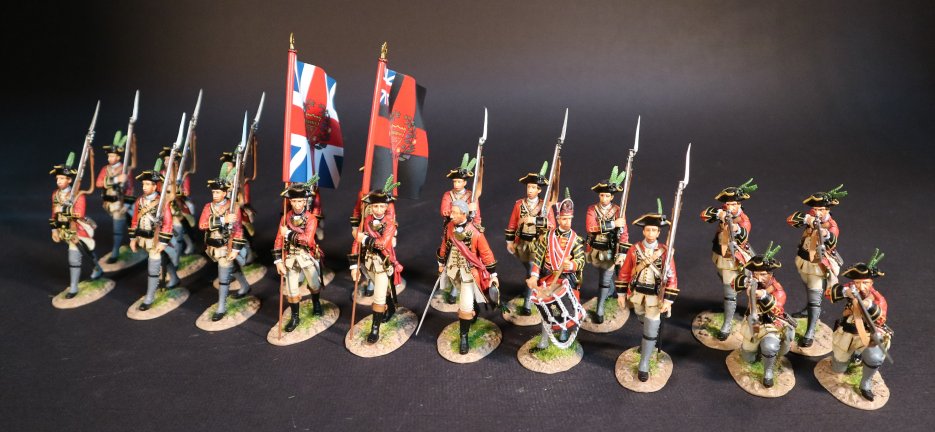
The 84th (Coote’s) Regiment was raised in January 1759, specifically for service in India.
The regiment was ordered home to be disbanded in 1764, but was instead reduced in India and most of the personnel were to enter the East India Company service.

WB84-05
THE SEVEN YEARS WAR,
THE THIRD CARNATIC WAR 1756-1763,
THE BATTLE OF WANDEWASH, 22nd JANUARY 1760,
THE BRITISH ARMY,
84th (COOTE’S) REGIMENT OF FOOT

WB84-06
THE SEVEN YEARS WAR,
THE THIRD CARNATIC WAR 1756-1763,
THE BATTLE OF WANDEWASH, 22nd JANUARY 1760,
THE BRITISH ARMY,
84th (COOTE’S) REGIMENT OF FOOT
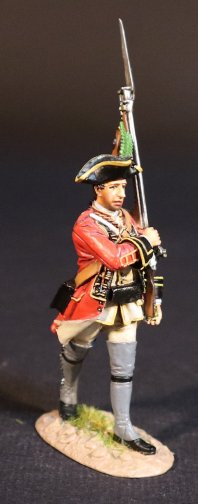
WB84-07
THE SEVEN YEARS WAR,
THE THIRD CARNATIC WAR 1756-1763,
THE BATTLE OF WANDEWASH, 22nd JANUARY 1760,
THE BRITISH ARMY,
84th (COOTE’S) REGIMENT OF FOOT

WB84-567N
THE SEVEN YEARS WAR,
THE THIRD CARNATIC WAR 1756-1763,
THE BATTLE OF WANDEWASH, 22nd JANUARY 1760,
THE BRITISH ARMY,
84th (COOTE’S) REGIMENT OF FOOT
THE FRENCH ARMY
LALLY’S (IRISH) REGIMENT
During the Seven Years War the regiment was ranked 109th, and was under the command of Thomas Arthur Comte de Lally-Tollendal
On March 6 1757, the 2nd battalion of the regiment left Brest on board a squadron under the command of Admiral d'Aché to reinforce the French posts in India. The fleet pursued by British men-of-war loitered on the voyage to Mauritius. It then took three months on his passage to the Coast of Coromandel.
On April 25th 1758, the fleet transporting the 2nd battalion finally arrived before the British Fort St. David. The 2nd Battalion took part in the operations on the Coast of Coromandel and in the Siege of Fort St. David until its capitulation on June 2nd.
From December 1758 to February 1759, the battalion took part in the unsuccessful Siege of Madras.
In 1759 the 2nd Battalion took part in the operations on the coast of Coromandel. At the beginning of August, it was in garrison at Chittapett (present day Chetpet). It broke into open mutiny and marched out of the fort with the avowed intention of joining the British. Their officers followed them, and by promises to discharge the arrears of their pay, now several months overdue, succeeded in Conciliating most of them, but 60 men persisted in their resolution and deliberately carried it out.

On January 22nd 1760, the battalion took part in the Battle of Wandewash.
Throughout the rest of the year, it was involved in the defense of Pondicherry. On September 4th, during the blockade of Pondicherry by a British amphibious force, Lally made an attack on the British camp which was repulsed after one redoubt had been taken by the French, 1 gun captured, 2 others spiked and a British officer and 3 men had been taken prisoner.
The Lally battalion was particularly distinguished in this occasion, losing 8 sergeants and 25 privates killed.
On January 15 1761, when Pondicherry surrendered, the regiment became prisoners of war.
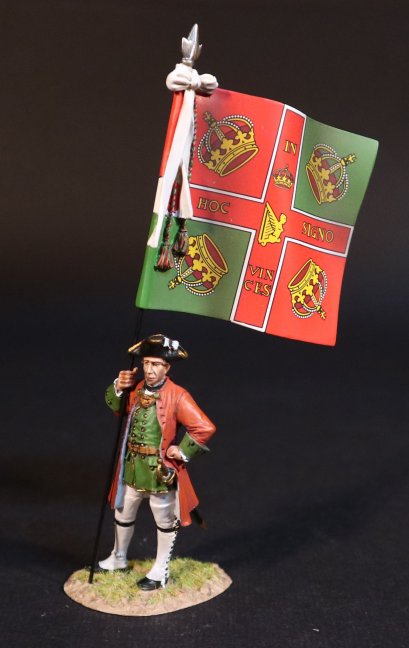
WFLAL-02
THE SEVEN YEARS WAR,
THE THIRD CARNATIC WAR 1756-1763,
THE BATTLE OF WANDEWASH, 22nd JANUARY 1760,
THE FRENCH ARMY,
LALLY’S (IRISH) REGIMENT
STANDARD BEARER
Thomas Arthur, Comte de Lally, Baron de Tollendal (13th January 1702 – 9th May 1766) was a French general of Irish Jacobite ancestry. Lally commanded French forces including two battalions of his own red coated Regiment of Lally of the Irish Brigadde, in India during the Seven Years’ War.
After a failed attempt to capture Madras he lost the Battle of Wandewash to British forces under Eyre Coote and then was forced to surrender the remaining French post at Ponticherry.
After time spent as a prisoner of war in Britain, Lally voluntarily returned to France to face charges where he was beheaded for his alleged failures in India. Ultimately the jealousies and disloyalties of other officers, together with insufficient resources and limited naval support prevented Lally from securing India for France. In 1778, he was publicly exonerated by Louis XVI from his alleged crime.
ORDRE MINCE AND ORDRE PROFONDE
In the 18th century, a fierce debate arose among tacticians, some backing the ordre mince and some backing the ordre profond. Infantry fighting based itself on two concepts.
To give a brief idea of these two conceptions: proponents of the ordre mince considered that fire was the determining factor in a combat thus the more the front of a unit was extended the more one could inflict losses to the enemy, weakening him to get the upper hand.
The Line, ordre mince, favoured firepower, and allowed the largest number of men to fire on the enemy force. However it was not very mobile, and could be easily broken by a shock attack or by cavalry.
The proponents of the ordre profond argued that it was not fire but shock which was the determining factor, allowing to crush the enemy lines with 6 ranks deep (or more) columns bristling with bayonets.
The English preferred the Ordre Mince (thin order) and had even developed salvo firing by sections which allowed a group of men (on each volley) to create a gap in the opposing formation. Less professional armies used salvoes in line formation, with three ranks, having one rank fire while the other two reloaded.
It is argued that the losses to each salvo were divided up amongst the mass of the opposing unit, and thus had a less damaging effect on morale than fire by section.
During the Seven Years’ War, it is the ordre mince in 3 ranks which was the most commonly used when infantry units deployed in order of battle.
From 1754, in the French army firing was made by section, platoon, tiers de rang, demi-rang or battalion.
In 1755, the regulation specified that fire should start from the central part of the battalion and proceed outwards.
Exercises in garrison or in camps drew attention that in real combat situations, firing procedure were much more difficult.
The Encyclopédie of 1777 describes the action of an infantryman during combat as follows:
“Fire is most often very uncertain, and nothing is more true. Whatever the position of an infantry troop, in open terrain or in mountainous country, it is undisputable that wind, dust or sun, noise and smoke, who are unavoidable, perpetual movements and unevenness of terrain make soldiers knock each others, and change order and union of the various parts of a troop and expose it to break; the quickness with which a soldier charge his musket, makes him often spill half his cartridge, or push it only halfway in the barrel; the barrel becomes burning hot and clogged by dint of firing; the gun lock gets dry and breaks down, or whose flint does not produce sparks any more; finally the ardour who gets on their nerves and stuns them; all of this contribute to disturb the exactness of fire, and to considerably diminish fire and its effect.”
It was in April 1759 that the war Minister, the Marechal de Belle-Isle, wrote to the Marechal de Contades, enjoining him to put his infantry in 6 ranks in encampment as well as in battle and to train them in this exercise.
The French armies of the 18th and early 19th centuries eventually placed a significant amount of emphasis on the ordre profonde, in part to counter the success of the English and Prussian ordre mince.
The ordre profonde was also appealing in that at least in theory, it would cure the problems with desertion, decisiveness and systematizing that the French had experienced throughout the 18th century, particularly in the Seven Years’ War.
**PLEASE CONTACT YOUR LOCAL DEALER FOR FURTHER INFORMATION**
THE EIGHTEENTH CENTURY COLLECTION
THE AMERICAN WAR OF INDEPENDENCE
THE BATTLE OF BUNKER HILL, 17th JUNE 1775.
THE ASSAULT ON THE REDOUBT AT BREED’S HILL
Boston was the third largest town in North America, and stood on a Peninsula connected to the mainland by a neck just wide enough to cross at high tide. The harbour, large enough to be strategically significant, and central to the town’s economy, was formed by a chain of islands stretching out to sea, guarded by reefs and ledges.
North west of Boston was Charlestown, a largely rural peninsula one and a half miles long. Charlestown stood at the south east corner with three hills behind it. Bunker’s Hill, nearest the neck of the Peninsula, Breed’s Hill 200 yards above the town and Moulton’s Hill to the north east.

On the 16th June 1775, 3 detachments from Massachusetts regiments under the command of Colonel William Prescott and engineer Captain Richard Gridley, crossed the Charlestown neck and arrived at Bunker Hill.
Captain Richard Gridley and Prescott disagreed as to where they should locate their defense. Some work was performed on Bunker Hill, but Breed’s Hill was closer to Boston and viewed as being more defensible, and they decided to build their primary redoubt there.
Prescott and his men began digging a square fortification about 130 ft a side with ditches and earthen walls. The walls of the redoubt were about 6 feet high.
Work began at midnight, and around 4am one of the British warships spotted the earthworks on Breed’s Hill and opened fire.
The British command agreed that the works posed a significant threat, but were at this time sufficiently incomplete and isolated to offer a chance of a successful attack.
The original British plan was to bypass the redoubt to the north and capture Bunker’s Hill and the neck of the peninsula, thus isolating the redoubt on Breed’s Hill.
The Americans repulsed two British assaults, with significant British casualties. The British captured the redoubt on their third assault, after the defenders had run out of ammunition. The colonists retreated over Bunker Hill, leaving the British finally in control of the Peninsula.
The battle was a tactical victory for the British, but it proved to be a sobering experience for them; they incurred many more casualties than the Americans had sustained, including many officers. The battle had demonstrated that inexperienced militia were able to stand up to regular army troops in battle. Subsequently, the battle discouraged the British from any further frontal attacks against well defended front lines. American casualties were much fewer, although their losses included General Joseph Warren, and Major Andrew McClary, the final casualty of the battle.
THE AMERICAN ARMY

ABHL-02
THE AMERICAN WAR OF INDEPENDENCE 1775-1783,
THE BATTLE OF BUNKER HILL, JUNE 17th 1775,
THE ASSAULT ON THE REDOUBT AT BREED’S HILL,
THE AMERICAN ARMY,
STANDARD BEARER
BRITISH MARINES

The Marines, which only became “Royal Marines” in 1802, were the Royal Navy’s private army, administered by the Admiralty and controlled by senior naval officers. The rank and file were volunteers and wore army style uniforms and equipment. However they were trained to serve on warships and undertake amphibious operations. The 50 companies, shared between Chatham, Portsmouth and Plymouth, were not regimented, and detachments, or in some cases individual replacements were assigned on an ad hoc basis.
The first Marines sent to Boston were to form a battalion of 600 men under Major Pitcairn, but by March only 336 were present, as they soon became an object of inter service rivalry over pay, food and conditions. Although initially physically inferior to their army comrades, and short of essential equipment for service on land, incessant drilling and regular marches into the countryside soon created a fine unit.
Another group of over 700 men arrived in May, and the whole force formed two battalions, with grenadier and light companies.
The 1st and 2nd Marines were to play an important part in the assault on the southern defences of the Breed’s Hill redoubt.

MBHL-09
THE AMERICAN WAR OF INDEPENDENCE 1775-1783,
THE BATTLE OF BUNKER HILL, JUNE 17th 1775,
THE ASSAULT ON THE REDOUBT AT BREED’S HILL,
BRITISH MARINES,
2 BRITISH MARINES
It was during one of the assaults by the 47th Regiment and the 1st Marines, that the American commander Prescott ordered his men to hold their fire until the British were within 30 yards. This action supposedly gave rise to the order, “Don’t fire till you see the whites of their eyes”!
The volley forced the Marines and regulars back out of range to regroup.
Adjutant, Lieutenant Waller, managed to reform two companies, and with the 47th Regiment on their left, the two battalions finally swarmed over the defences and into the redoubt, probably being the first troops to enter.

MBHL-09N
THE AMERICAN WAR OF INDEPENDENCE 1775-1783,
THE BATTLE OF BUNKER HILL, JUNE 17th 1775,
THE ASSAULT ON THE REDOUBT AT BREED’S HILL,
BRITISH MARINES,
4 BRITISH MARINES
This third attack was made at the point of the bayonet and successfully carried the redoubt. However the final volleys of fire from the colonists cost the life of Major Pitcairn. The defenders had run out of ammunition, redusing the battle to close combat. The advantage turned to the British as their troops were equipped with bayonets on their muskets, while most of the colonists were not.
Colonel Prescott, one of the last men to leave the redoubt, parried bayonet thrusts with his normally ceremonial saber.

MBHL-14
THE AMERICAN WAR OF INDEPENDENCE 1775-1783,
THE BATTLE OF BUNKER HILL, JUNE 17th 1775,
THE ASSAULT ON THE REDOUBT AT BREED’S HILL,
BRITISH MARINES,
2 BRITISH MARINE CASUALTIES

MBHL-14N
THE AMERICAN WAR OF INDEPENDENCE 1775-1783,
THE BATTLE OF BUNKER HILL, JUNE 17th 1775,
THE ASSAULT ON THE REDOUBT AT BREED’S HILL,
BRITISH MARINES,
4 BRITISH MARINE CASUALTIES
THE SEVEN YEARS WAR
THE THIRD CARNATIC WAR 1756-1763
THE BATTLE OF WANDEWASH, 22nd JANUARY 1760
THE BRITISH ARMY
The Battle of Wandewash was a confrontation between the French under the command of The Comte de Lally, and the British Sir Eyre Coote. It was the decisive battle in the Anglo French struggle in southern India during the Seven Years War.
Lally, cut off from sea support by the withdrawal of Admiral d’Aché’s fleet and hampered by a lack of funds and by dissensions among his troops, tried to recover the fort of Wandiwash near Pondicherry.
There he was attacked and routed by Coote, with about 1,700 British troops against about 2,000 French. Lally’s best general, the marquis de Bussy, was captured. The French were thereafter confined to Pondicherry, which surrendered on Jan. 16, 1761, after much privation. Lally was later imprisoned and executed, after a trial in Paris, for alleged treason
The following two British regular units served in India and were present at the battle of Wandewash. It should be noted however that it was rare for these units to serve as complete battalions, and that they were generally broken up into detachments.
THE 84th (COOTE’S) REGIMENT OF FOOT

The 84th (Coote’s) Regiment was raised in January 1759, specifically for service in India.
The regiment was ordered home to be disbanded in 1764, but was instead reduced in India and most of the personnel were to enter the East India Company service.

WB84-05
THE SEVEN YEARS WAR,
THE THIRD CARNATIC WAR 1756-1763,
THE BATTLE OF WANDEWASH, 22nd JANUARY 1760,
THE BRITISH ARMY,
84th (COOTE’S) REGIMENT OF FOOT

WB84-06
THE SEVEN YEARS WAR,
THE THIRD CARNATIC WAR 1756-1763,
THE BATTLE OF WANDEWASH, 22nd JANUARY 1760,
THE BRITISH ARMY,
84th (COOTE’S) REGIMENT OF FOOT

WB84-07
THE SEVEN YEARS WAR,
THE THIRD CARNATIC WAR 1756-1763,
THE BATTLE OF WANDEWASH, 22nd JANUARY 1760,
THE BRITISH ARMY,
84th (COOTE’S) REGIMENT OF FOOT

WB84-567N
THE SEVEN YEARS WAR,
THE THIRD CARNATIC WAR 1756-1763,
THE BATTLE OF WANDEWASH, 22nd JANUARY 1760,
THE BRITISH ARMY,
84th (COOTE’S) REGIMENT OF FOOT
THE FRENCH ARMY
LALLY’S (IRISH) REGIMENT
During the Seven Years War the regiment was ranked 109th, and was under the command of Thomas Arthur Comte de Lally-Tollendal
On March 6 1757, the 2nd battalion of the regiment left Brest on board a squadron under the command of Admiral d'Aché to reinforce the French posts in India. The fleet pursued by British men-of-war loitered on the voyage to Mauritius. It then took three months on his passage to the Coast of Coromandel.
On April 25th 1758, the fleet transporting the 2nd battalion finally arrived before the British Fort St. David. The 2nd Battalion took part in the operations on the Coast of Coromandel and in the Siege of Fort St. David until its capitulation on June 2nd.
From December 1758 to February 1759, the battalion took part in the unsuccessful Siege of Madras.
In 1759 the 2nd Battalion took part in the operations on the coast of Coromandel. At the beginning of August, it was in garrison at Chittapett (present day Chetpet). It broke into open mutiny and marched out of the fort with the avowed intention of joining the British. Their officers followed them, and by promises to discharge the arrears of their pay, now several months overdue, succeeded in Conciliating most of them, but 60 men persisted in their resolution and deliberately carried it out.

On January 22nd 1760, the battalion took part in the Battle of Wandewash.
Throughout the rest of the year, it was involved in the defense of Pondicherry. On September 4th, during the blockade of Pondicherry by a British amphibious force, Lally made an attack on the British camp which was repulsed after one redoubt had been taken by the French, 1 gun captured, 2 others spiked and a British officer and 3 men had been taken prisoner.
The Lally battalion was particularly distinguished in this occasion, losing 8 sergeants and 25 privates killed.
On January 15 1761, when Pondicherry surrendered, the regiment became prisoners of war.

WFLAL-02
THE SEVEN YEARS WAR,
THE THIRD CARNATIC WAR 1756-1763,
THE BATTLE OF WANDEWASH, 22nd JANUARY 1760,
THE FRENCH ARMY,
LALLY’S (IRISH) REGIMENT
STANDARD BEARER
Thomas Arthur, Comte de Lally, Baron de Tollendal (13th January 1702 – 9th May 1766) was a French general of Irish Jacobite ancestry. Lally commanded French forces including two battalions of his own red coated Regiment of Lally of the Irish Brigadde, in India during the Seven Years’ War.
After a failed attempt to capture Madras he lost the Battle of Wandewash to British forces under Eyre Coote and then was forced to surrender the remaining French post at Ponticherry.
After time spent as a prisoner of war in Britain, Lally voluntarily returned to France to face charges where he was beheaded for his alleged failures in India. Ultimately the jealousies and disloyalties of other officers, together with insufficient resources and limited naval support prevented Lally from securing India for France. In 1778, he was publicly exonerated by Louis XVI from his alleged crime.
ORDRE MINCE AND ORDRE PROFONDE
In the 18th century, a fierce debate arose among tacticians, some backing the ordre mince and some backing the ordre profond. Infantry fighting based itself on two concepts.
To give a brief idea of these two conceptions: proponents of the ordre mince considered that fire was the determining factor in a combat thus the more the front of a unit was extended the more one could inflict losses to the enemy, weakening him to get the upper hand.
The Line, ordre mince, favoured firepower, and allowed the largest number of men to fire on the enemy force. However it was not very mobile, and could be easily broken by a shock attack or by cavalry.
The proponents of the ordre profond argued that it was not fire but shock which was the determining factor, allowing to crush the enemy lines with 6 ranks deep (or more) columns bristling with bayonets.
The English preferred the Ordre Mince (thin order) and had even developed salvo firing by sections which allowed a group of men (on each volley) to create a gap in the opposing formation. Less professional armies used salvoes in line formation, with three ranks, having one rank fire while the other two reloaded.
It is argued that the losses to each salvo were divided up amongst the mass of the opposing unit, and thus had a less damaging effect on morale than fire by section.
During the Seven Years’ War, it is the ordre mince in 3 ranks which was the most commonly used when infantry units deployed in order of battle.
From 1754, in the French army firing was made by section, platoon, tiers de rang, demi-rang or battalion.
In 1755, the regulation specified that fire should start from the central part of the battalion and proceed outwards.
Exercises in garrison or in camps drew attention that in real combat situations, firing procedure were much more difficult.
The Encyclopédie of 1777 describes the action of an infantryman during combat as follows:
“Fire is most often very uncertain, and nothing is more true. Whatever the position of an infantry troop, in open terrain or in mountainous country, it is undisputable that wind, dust or sun, noise and smoke, who are unavoidable, perpetual movements and unevenness of terrain make soldiers knock each others, and change order and union of the various parts of a troop and expose it to break; the quickness with which a soldier charge his musket, makes him often spill half his cartridge, or push it only halfway in the barrel; the barrel becomes burning hot and clogged by dint of firing; the gun lock gets dry and breaks down, or whose flint does not produce sparks any more; finally the ardour who gets on their nerves and stuns them; all of this contribute to disturb the exactness of fire, and to considerably diminish fire and its effect.”
It was in April 1759 that the war Minister, the Marechal de Belle-Isle, wrote to the Marechal de Contades, enjoining him to put his infantry in 6 ranks in encampment as well as in battle and to train them in this exercise.
The French armies of the 18th and early 19th centuries eventually placed a significant amount of emphasis on the ordre profonde, in part to counter the success of the English and Prussian ordre mince.
The ordre profonde was also appealing in that at least in theory, it would cure the problems with desertion, decisiveness and systematizing that the French had experienced throughout the 18th century, particularly in the Seven Years’ War.
**PLEASE CONTACT YOUR LOCAL DEALER FOR FURTHER INFORMATION**

